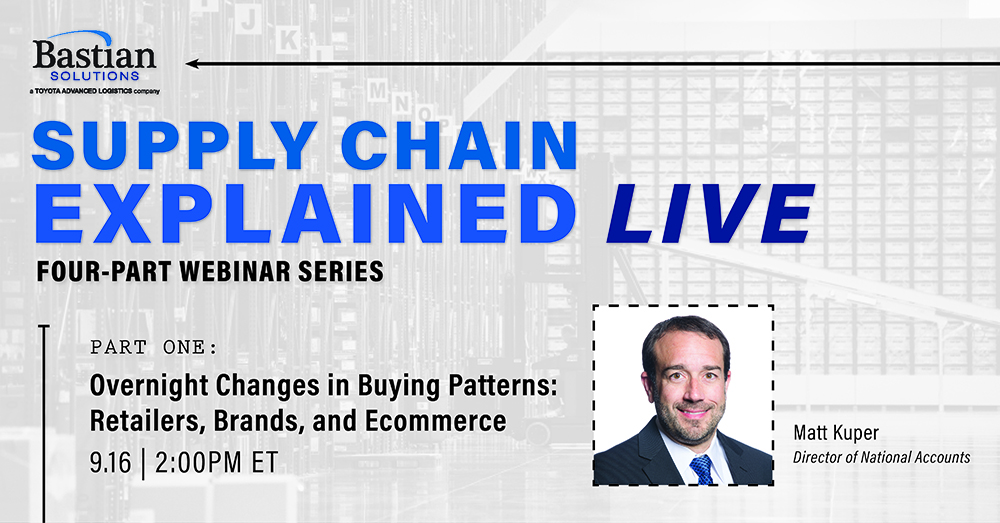
Ecommerce Automation: Addressing Overnight Changes in Buying Patterns
Matt Kuper | 24 September 2020
In the first installment of our Supply Chain Explained: LIVE webinar series, Director of National Accounts Matt Kuper discussed the massive impact that the COVID-19 pandemic has had on the ecommerce supply chain.
With retailers shifting to more online sales, grocers managing more buy online, pick up in store (BOPIS) orders, and supply chain interruptions across the globe hindering the ability to order parts or products, we saw a major shift in buying patterns for both B2B and B2C.
The workforce was also majorly impacted, with shutdowns, layoffs, furloughs and employees hesitant to report to work over fear of contracting the virus. Many warehouses and distribution centers were forced to redefine processes to maintain safe working environments while continuing to meet consumer demand.
With potential supply chain interruptions, there are many reasons to have additional inventory on hand to ensure customers receive their orders in a timely manner. Now more than ever, a better understanding of the supply chain is critical to providing the service levels customers expect.
But how can ecommerce retailers handle these large shifts in strategy? Determining the right solution can be daunting, but independent systems integrators like Bastian Solutions are prepared to review data, create consulting studies, and consider the variables of your entire operation to ensure all goals are met, within budget.
Automation is beginning to feel less like and option, and more like a necessity to compete in today’s markets. Increasing storage density, speeding up order fulfillment, diversifying your supply chain, and even changing from a brick and mortar store replenishment facility to omnichannel, are all things to consider. Goods to person systems, advanced picking technologies, sortation, and replenishment automation options exist on a variety of levels to meet operational needs.
The key takeaway to avoid another pitfall caused by unforeseen circumstances is carefully considering all of your supply chain partners. Sourcing a variety of suppliers, automation and packaging flexibility are things that need procedure, and backup procedure, to ensure if (or when) things go wrong, you have options.
To learn more, view the full webinar recording for all the information.
If you’re short on time, here are the key timestamps:
- Industry COVID-19 Challenges/Concerns: 3:14
- Results of COVID-19 Challenges/Concerns: 7:16
- Determining the right solutions: 10:44
- Inventory: 15:06
- Picking technologies: 20:21
- Goods to Person technologies: 23:04
- Good to Robot technologies: 28:06
- Sortation: 29:10
- Replenishment: 32:13
- Supply Chain Partners: 34:58
- Q&A: 39:39
Matt Kuper, the VP of Global Sales and Applications at Bastian Solutions, has more than 15 years of experience in the material handling industry handling a variety of systems projects and technologies including high-speed sortation, pick modules, goods-to-person, and pallet handling systems. He joined Bastian Solutions in 2013 and has since overseen some of the company’s largest and most complex integration projects.
Comments
No comments have been posted to this Blog Post
Leave a Reply
Your email address will not be published.
Comment
Thank you for your comment.